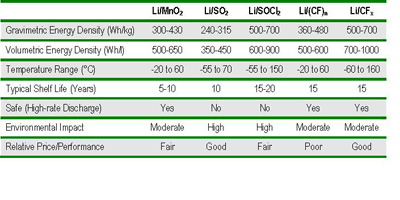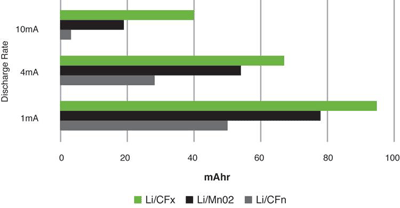Side by side, here are the basic properties of five different primary Li batteries
BY ERIC LIND
Contour Energy Systems
Azusa, CA
http://www.contourenergy.com
The element lithium possesses fundamental properties that make it ideal for use as the anode in both primary and rechargeable batteries. In primary batteries, vendors have paired the popular lithium anode with a variety of cathode and electrolyte materials, resulting in the wide choice of different types of batteries available today.
This article compares the basic properties of five different of primary lithium batteries. The content is divided into two sections: the first with basic reference information for each type; and the second containing a comparison of all five.
Primary Li battery data
The reference information provided here includes each battery type’s basic properties, advantages and disadvantages, and typical applications. Note that because energy densities vary with the different form factors used in different situations, the ranges used here depict typical values for cells in applications requiring moderate to high rates of discharge.
Lithium/Manganese Dioxide
Li/MnO2 Basic
Properties: Energy density of 300-430 Wh/kg and 500-650 Wh/l;
Operating temperature range: 20° to 60°C
Advantages: Low cost, safe operation
Disadvantages: Low gravimetric and volumetric energy densities. Limited operating temperature range
Typical apps: Low to moderate discharge in consumer electronics, military communications, transportation, RFID, automated meter reading, medical defibrillators, and memory backup
Lithium/Sulfur Dioxide
Li/SO2 Basic
Properties: Energy density of 240-315 Wh/kg and 350-450 Wh/l
Operating temperature range: 55° to 70°C
Advantages: Low cost, high pulse-power capability, low operating temperature
Disadvantages: Low volumetric energy and power densities. Limited high operating temperature. Suffers from passivation. Safety concerns during high sustained discharge (causing overheating and pressure build-up)
Generates toxic waste
Typical apps: Military/aerospace communications
Lithium/Thionyl Chloride
Li/SOCl2 Basic
Properties: Energy density of 500-700 Wh/kg and 600-900 Wh/l
Operating temperature range: 55° to 150°C
Advantages: High volumetric energy density, high pulse-power capability
long service/shelf life, wide operating temperature range.
Disadvantages: Low gravimetric energy and power densities, suffers from passivation, safety concerns during high sustained discharge (causing pressure build-up), generates toxic waste
Typical apps : Commercial/consumer electronics, military communications, transportation, RFID, automated meter reading, and memory backup
Lithium/Polycarbon
Monofluoride
Li/(CF)N Basic
Properties: Energy density of 360-480 Wh/kg and 500-600 Wh/l
Operating temperature range : 20° to 60°C
Advantages: Long service/shelf life, safe operation
Disadvantages: Low gravimetric energy density, limited operating temperature range, poor performance at low temperatures
Typical apps: Low to moderate discharge in consumer electronics, military communications, transportation, RFID, automated meter reading, medical defibrillators, and memory backup
Lithium/Carbon Fluoride
Li/CFx Basic
Properties: Energy density of 500-700 Wh/kg and 700-1000 Wh/l
Operating temperature range: 60° to 160°C
Advantages: High energy and power densities, customizable cathode for optimizing energy/power densities
Very wide operating temperature range, long service/shelf life, safe operation
Disadvantages: Moderately higher cost but with improved price/performance
Typical apps: Low to high discharge in portable electronics, military and search & rescue communications, industrial, transportation, RFID, automated meter reading, and medical defibrillators backup
The comparison
Table 1 provides a summary comparison of some important characteristics for all five types of primary lithium batteries. (Traditionally, lithium carbon monofluoride encompassed a wide range of technologies. However, due to significant differences in performance, I have created the carbon fluoride subset in order to highlight those differences.)

Table 1. A summary of important characteristics for the five primary lithium batteries
Energy density
Both the weight and the size of a battery are critical in many applications, especially when multiple batteries are needed to deliver adequate power for the required service life. For both gravimetric (weight) and volumetric (size) energy densities, carbon fluoride enjoys a distinct advantage with ratings of 500 to 700 Wh/kg and 700 to 1000 Wh/l.
Power density
The total capacity of a battery is characterized by its power density, which varies as a function of the current drawn by the application. Power density varies even more based on the form factor of the battery, making general comparisons unreliable. Such comparisons can, nevertheless, be made under specific circumstances. Note how low a current draw, such as 1 mA in Fig. 1 above, enables a battery to have a higher power density measured here in milliamp-hours (mAhr).
The capacity advantage carbon fluoride batteries have derives from the ability to customize or tune the cathode to favor higher energy or power densities. Customization takes place during the manufacturing process by altering how fluorine is introduced into the carbon structure at the atomic level.

Fig. 1. These test results of available capacity at three different rates of discharge (to 2.0 V) for three different 2016 coin cells help quantify the carbon fluoride battery’s improvements in power density at low, moderate and high discharge rates
Temperature range
Operating temperature range is generally not a significant factor in typical applications because all five batteries operate over a fairly wide range, with thionyl chloride and carbon fluoride exhibiting the best characteristics. Only two of the contenders, manganese dioxide and polycarbon monofluoride, fail to operate dependably below 20C (4F), which may preclude their use in frigid environments.
Shelf life
Shelf life is critical in those applications where a device may be used only rarely but must operate dependably when it is. Examples include public safety, search and rescue, and certain medical equipment. All five types of batteries provide respectable shelf lives, with thionyl chloride having the longest.
Safety
The use of liquid or gaseous materials for either the cathode or electrolyte can raise safety concerns during a battery’s handling and use. The worst offenders here are sulfur dioxide and thionyl chloride, which both require the use of pressurized canisters that might rupture and vent or leak corrosive or noxious gases.
Environmental impact
All lithium batteries are made with some fairly dangerous chemicals, which can have an adverse impact on the environment during their manufacture or improper disposal. Not surprisingly, the worst offenders here again are Sulfur Dioxide and thionyl chloride, as these both contain toxic chemicals that can poison ground water.
Price/performance
As this comparison has shown, carbon fluoride enjoys some significant advantages over all other types of primary lithium batteries. Its single disadvantage at this time is its moderately higher cost. But when taking into account the increased performance based on higher energy and power densities, CFx offers the best price/performance ratio of all these alternatives. And over time, with additional advancements and growing economies of scale in manufacturing, carbon fluoride’s price/performance advantage can be expected to improve. ■
Advertisement
Learn more about Contour Energy Systems





